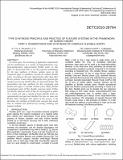Type Synthesis Principle and Practice of Flexure Systems in the Framework of Screw Theory: Part II—Numerations and Synthesis of Complex Flexible Joints
Author(s)
Yu, J. J.; Pei, X.; Li, S. Z.; Su, Hai-jun; Culpepper, Martin; Hopkins, Jonathan B; ... Show more Show less
Download553_1.pdf (1.014Mb)
PUBLISHER_POLICY
Publisher Policy
Article is made available in accordance with the publisher's policy and may be subject to US copyright law. Please refer to the publisher's site for terms of use.
Terms of use
Metadata
Show full item recordAbstract
In recent years, the increasing of application requirements call for development of a variety of high-performance (e.g. large-displacement, high-precision) flexible joints. In this paper we demonstrate how to use the proposed methodology for the type synthesis of flexure systems given in the companion paper to synthesize concepts for complex flexible joints. According to the joint characteristics other than other flexure systems, a basic design philosophy and a general type synthesis process for flexible joints are presented firstly. The numerations and type synthesis for four commonly used flexible joint types, i.e. flexible revolute joints (FRJs), flexible translational joints (FTJs), flexible universal joints (FUJs), and flexible spherical joints (FSJs) are investigated in detail. As a result, not only a variety of known flexible joints are systematically surveyed and classified, but also are some new flexible joints developed. The output of this process is the derivation of a multiple of flexible joint concepts that would then be modeled and optimized by existing modeling and analysis methods.
Date issued
2010-08Department
Massachusetts Institute of Technology. Department of Mechanical EngineeringJournal
Volume 2: 34th Annual Mechanisms and Robotics Conference, Parts A and B
Publisher
ASME International
Citation
Yu, J. J., X. Pei, S. Z. Li, Hai-jun Su, J. B. Hopkins, and M. L. Culpepper. “Type Synthesis Principle and Practice of Flexure Systems in the Framework of Screw Theory: Part II—Numerations and Synthesis of Complex Flexible Joints.” Volume 2: 34th Annual Mechanisms and Robotics Conference, Parts A and B (2010), Montreal, Quebec, Canada, ASME International, 2010. © 2010 ASME International
Version: Final published version
ISBN
978-0-7918-4410-6